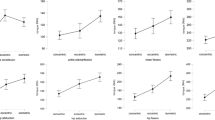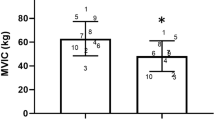Abstract
The aim of this study was to examine submaximal isometric force production guided by perceptual feelings of exertion. Thirty young adults performed isometric knee extensions on an isokinetic dynamometer. Subjects performed five different tests; the first test was the same for all subjects (standard naïve test). During the standard naïve test, subjects were asked to randomly produce force at perceived contraction intensities (25%, 50% and 75% of their maximum voluntary contraction (MVC)), with 100% MVC performed as the final intensity. All intensities, including the 100% MVC, were randomly performed in the other four tests (control tests 1 and 2, post 20% MVC and post 100% MVC tests). Post 20% MVC and post 100% MVC tests included fatiguing isometric exercise at 20% and 100% MVC respectively, which were performed prior to the test protocol. Results show that absolute peak force increased with increasing intensity (P<0.001) during all tests. During the standard naïve test, absolute peak force at 25% and 50% MVC was significantly lower (P=0.009) compared to control test 2, post 20% MVC and 100% MVC tests, and relative peak force was lower at all intensities compared to all other tests (P<0.001). Absolute and relative peak force was most accurate at 50% MVC (−12.06 N and −2.42%, respectively). Prior fatiguing isometric exercise did not affect the subsequent perceptual response range. In conclusion, isometric force was most accurate at 25% MVC but under-produced (perceptually overestimated) during higher contraction intensities preceding a maximal voluntary contraction (100% MVC). The ability to match absolute force with target contraction intensities was most accurate at 50% MVC during all five experimental conditions and poor at opposite ends of the force domain. Furthermore, prior fatiguing isometric exercise did not have an effect on the subsequent perceptual response range.

Similar content being viewed by others
References
Bigland-Ritchie B, Johansson R, Lippold OC, Smith S, Woods JJ (1983) Changes in motoneurone firing rates during sustained maximal voluntary contractions. J Physiol 340:335–346
Borg GA (1982) Psychophysical bases of perceived exertion. Med Sci Sports Exerc 14:377–381
Cafarelli E, Bigland-Ritchie B (1979) Sensation of static force in muscles of different length. Exp Neurol 65:511–525
Cooper DF, Grimby G, Jones DA, Edwards RH (1979) Perception of effort in isometric and dynamic muscular contraction. Eur J Appl Physiol Occup Physiol 41:173–180
Enoka RM, Stuart DG (1992) Neurobiology of muscle fatigue. J Appl Physiol 72:1631–1648
Gandevia SC, McCloskey DI (1978) Interpretation of perceived motor commands by reference to afferent signals. J Physiol 283:193–199
Hampson DB, St Clair GA, Lambert MI, Noakes TD (2001) The influence of sensory cues on the perception of exertion during exercise and central regulation of exercise performance. Sports Med 31:935–952
Horstman D, Kowal D, Vaughan L, Stivanelli A (1979c) The influence of previous physical experience on the perception of work effort. Med Sci Sports Exerc 11:79
Hutton RS, Enoka RM, Suzuki S (1984) Activation history and constant errors in human force production. Brain Res 307:344–346
Jackson AW, Dishman RK (2000) Perceived submaximal force production in young adult males and females. Med Sci Sports Exerc 32:448–451
Jones LA, Hunter IW (1982) Force sensation in isometric contractions: a relative force effect. Brain Res 244:186–189
Jones LA, Hunter IW (1983a) Effect of fatigue on force sensation. Exp Neurol 81:640–650
Jones LA, Hunter IW (1983b) Perceived force in fatiguing isometric contractions. Percept Psychophys 33:369–374
Kumar S, Simmonds M (1994) The accuracy of magnitude production of submaximal precision and power grips and gross motor efforts. Ergonomics 37:1345–1353
Pandolf KB (1983) Advances in the study and application of perceived exertion. Exerc Sport Sci Rev 11:118–158
Pincivero DM, Gear WS (2000) Quadriceps activation and perceived exertion during a high intensity, steady state contraction to failure. Muscle Nerve 23:514–520
Pincivero DM, Gear WS, Moyna NM, Robertson RJ (1999) The effects of rest interval on quadriceps torque and perceived exertion in healthy males. J Sports Med Phys Fitness 39:294–299
Pincivero DM, Coelho AJ, Erikson WH (2000) Perceived exertion during isometric quadriceps contraction. A comparison between men and women. J Sports Med Phys Fitness 40:319–326
Pincivero DM, Coelho AJ, Campy RM, Salfetnikov Y, Bright A (2001) The effects of voluntary contraction intensity and gender on perceived exertion during isokinetic quadriceps exercise. Eur J Appl Physiol 84:221–226
Pincivero DM, Coelho AJ, Campy RM, Salfetnikov Y, Suter E (2003a) Knee extensor torque and quadriceps femoris EMG during perceptually-guided isometric contractions. J Electromyogr Kinesiol 13:159–167
Pincivero DM, Dixon PT, Coelho AJ (2003b) Knee extensor torque, work, and EMG during subjectively graded dynamic contractions. Muscle Nerve 28:54–61
Pincivero DM, Coelho AJ, Campy RM (2004) Gender differences in perceived exertion during fatiguing knee extensions. Med Sci Sports Exerc 36:109–117
Robertson RJ, Noble BJ (1997) Perception of physical exertion: methods, mediators, and applications. Exerc Sport Sci Rev 25:407–452
Tihanyi J, Apor P, Fekete G (1982) Force-velocity-power characteristics and fiber composition in human knee extensor muscles. Eur J Appl Physiol Occup Physiol 48:331–343
Woods S, Bridge T, Nelson D, Risse K, Pincivero DM (2004) The effects of rest interval length on ratings of perceived exertion during dynamic knee extension exercise. J Strength Cond Res 18:540–545
Acknowledgements
The Medical Research Council of South Africa, the Nellie Atkinson and the Harry Crossley Staff Research Funds of the University of Cape Town, Discovery Health and the National Research Foundation of South Africa, through the THRIP initiative, provided financial assistance for this study.
Author information
Authors and Affiliations
Corresponding author
Rights and permissions
About this article
Cite this article
West, S.J., Smith, L., Lambert, E.V. et al. Submaximal force production during perceptually guided isometric exercise. Eur J Appl Physiol 95, 537–542 (2005). https://doi.org/10.1007/s00421-005-0004-9
Accepted:
Published:
Issue Date:
DOI: https://doi.org/10.1007/s00421-005-0004-9




